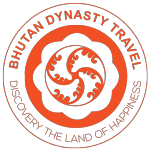History
Bhutan’s early history is steeped in mythology and remains obscure. It may have been inhabited as early as 2000 BC and there is a legend that it was ruled or controlled by a Cooch-Behar king, Sangaldip, around the 7th century B.C., but not much was known until the introduction of Tibetan Buddhism in the 9th century, when turmoil in Tibet forced many monks to flee to Bhutan. In the 12th century, the Drukpa Kagyupa school was established and remains the dominant form of Buddhism in Bhutan today. The country’s political history is intimately tied to its religious history and the relations among the various monastic schools and monasteries.
In 1907, Ugyen Wangchuck was elected as the hereditary ruler of Bhutan, crowned on December 17, 1907, and installed as the head of state Druk Gyalpo (Dragon King). In 1910, King Ugyen and the British signed the Treaty of Punakha which provided that British India would not interfere in the internal affairs of Bhutan if the country accepted external advice in its external relations. When Ugyen Wangchuck died in 1926, his son Jigme Wangchuck became the next ruler, and when India gained independence in 1947, the new Indian Government recognized Bhutan as an independent country. In 1949, India and Bhutan signed the Treaty of Peace and Friendship, which provided that India would not interfere in Bhutan’s internal affairs but would be guided by India in its foreign policy. Succeeded in 1952 by his son Jigme Dorji Wangchuck, Bhutan began to slowly emerge from its isolation and began a program of planned development. Bhutan became a member of the United Nations in 1971, and the National Assembly was established and a new code of law, as well as the Royal Bhutanese Army and the High Court.
In 1972, Jigme Singye Wangchuck ascended the throne at age 20. He emphasized modern education, decentralization of governance, the development of hydroelectricity and tourism and improvements in rural developments. He was perhaps best known internationally for his overarching development philosophy of “gross national happiness.” It recognizes that there are many dimensions to development and that economic goals alone are not sufficient. Satisfied with Bhutan’s transitioning democratization process, he abdicated in December 2006 rather than wait until the promulgation of the new constitution in 2008. His son, Jigme Khesar Namgyel Wangchuck, became King upon his abdication.
Festivals
The annual festival is called ‘Tshechu’. It is one of the most exciting experiences that the visitor can have in Bhutan. It is celebrated in honour of Guru Padmasambhava who visited Bhutan in 7th century.
During the Tshechu, the monks and laymen perform mask dances and the religious skits. It is also the time for the people to socialize and rejoice. Men, women and children are attired in their best silk and brocade, and intricately woven colourful ghos and kiras.
In some festivals you can witness the unveiling of a “thongdrel,” (a giant appliquéd thangka) that is hung from a wall in the Dzong’s courtyard. Punakha Dzong has the largest thongdrel in Bhutan.
Art & Architecture
The traditional Bhutanese arts and architecture are unique. They are highly decorative and ornamental. The traditional Bhutanese architecture has no nails or iron bars. The Bhutanese architectural grandeur is exhibited in the form of Dzongs, monasteries, temples, chortens and traditional Bhutanese houses. The Dzong architecture is one of the most elegant and harmonious in the world. The genius of Bhutanese art is best expressed in frescoes and paintings. Bhutan’s thangkas and mandalas depict an artistic skill and a rare exquisite fineness. The mandala or mystic circle represents the Buddhist concept of cosmogony of the universe. The statues are made of wood, stones, bronze, coral, pearl and other expensive materials, which depicts fine craftsmanship of the Bhutanese artists.
Flora & Fauna
Bhutan has about 72% of its area under forest cover. Over 5000 species of plants grow in Bhutan. These include 300 species of medicinal plants, over 50 species of rhododendron and 600 species of orchids.
The great variety of fauna includes: elephants, tigers, buffalo, one horned rhinoceros (rhinoceros unicornis), leopards (panthara pardus), gaur, red pandas, langur monkeys, wild boar, deer, white-collared black bears, yaks (bos gruniens), tahr (hemitragus jemlahicus) and goral (naemorhedus goral). Brown trout and local fishes are found in northern rivers and lakes, while in the south the rivers are full of masheer.
The rare and exotic species found in Bhutan are: golden langur (found only in Bhutan), pangolin, pygmy hog, snow leopard, red pandas, wild buffalo, monal peasant, peacock peasant, raven, rufous-necked hornbill, white-bellied heron, common shelduck, ruddy duck, black necked crane, golden masheer, spotted deer, leopard, leopard cat, himalayan black bear, serow, snow leopard, takin, musk deer, himalayan brown bear, himalayan marten, tiger, hornbills, pheasants, mountain goats and timid blue sheep.
About 675 species of birds have been recorded in Bhutan and more than 16 different species of birds are included in the lists of endangered species.
Sports
Bhutan’s national sport is archery, and competitions are held regularly in most villages. It differs from Olympic standards in technical details such as the placement of the targets and atmosphere. There are two targets placed over 100 meters apart and teams shoot from one end of the field to the other. Each member of the team shoots two arrows per round. Traditional Bhutanese archery is a social event, and competitions are organized between villages, towns, and amateur teams. There is usually plenty of food and drink complete with singing and dancing. Attempts to distract an opponent include standing around the target and making fun of the shooter’s ability. Darts (khuru) is an equally popular outdoor team sport, in which heavy wooden darts pointed with a 10 cm nail are thrown at a paperback-sized target 10 to 20 meters away.




